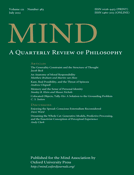-
Views
-
Cite
Cite
C. S. Sutton, Colocated Objects, Tally-Ho: A Solution to the Grounding Problem, Mind, Volume 121, Issue 483, July 2012, Pages 703–730, https://doi.org/10.1093/mind/fzs078
Close - Share Icon Share
Abstract
Are a statue and the lump of clay that constitutes it one object or two? Many philosophers have answered ‘two’ because the lump seems to have properties, such as the property of being able to survive flattening, that the statue lacks. This answer faces a serious problem: it seems that nothing grounds the difference in properties between colocated objects. The statue and lump are in the same environment and inherit properties from the same composing parts. But it seems that differences in properties should be grounded. For this reason, philosophers including Mark Heller, Dean Zimmerman, Theodore Sider, Trenton Merricks, and Eric Olson have rejected the answer ‘two’.
I offer a solution to the grounding problem, in order to revive the traditional account. I argue that extrinsic relations contribute to the supervenience base of many kinds or sorts, and these extrinsic relations ground differences between colocated objects, such as statues and lumps of clay, human beings and lumps of tissue, and planets and masses of matter. The same collection of parts can stand in more than one extrinsic relation, with each relation grounding the composition of a distinct kind of object. In cases in which this happens, the properties of each object differ from the properties of other objects that share the same parts.



